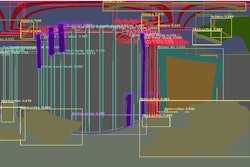
In the past, construction teams were tasked with using multiple apps and software to cover every aspect of their construction business. Sounds easy enough, but the reality of this approach was not so simple. Spread out among users, multiple logins, lost passwords and confusing user experiences led to workers throwing up their hands in frustration and construction leaders not getting their investment value back from their technology. Fortunately, this is where modern mobile workforce solutions can help.
To improve your construction software’s return on investment (ROI) in 2022, follow these steps to increase your data usage, productivity, and profitability.
1. Integrate Applications within a Mobile Workforce Solution
Having a mobile workforce solution that integrates with a wide range of third-party applications provides the flexibility to get all your business activities done in one location. Some common cloud-based applications to integrate with a quality mobile workforce solution include QuickBooks accounting software, Acumatica cloud ERP solutions, Sage Intaact, Procore project management solution, ADP, Paychex, UKG and other payroll and HR based programs. Construction projects typically have lots of moving parts, so it’s vital to have systems like these in place to maintain an audit trail for each step of these business processes.
Connecting third-party applications to your mobile workforce software enables you to deploy web-to-web connections for accounting, CRM, time management, digital form submissions and asset and tool tracking. You won’t have to worry about lost papers or missing emails any longer. The accounting department will have everything they require to handle finances in one place and at their fingertips. They will no longer need to track down multiple individuals to fill in gaps from missing information.
Platform integrations even make collecting sign-offs, approvals and signatures easy to request and obtain, and they’re available immediately on completion.
“Integration is a term that’s often overused or misspoken about,” said Mike Gillum, a product specialist at Acumatica. “It’s really the ability to gather data in one central location and have players in your company and outside of your company, both internal and external, accessing that information.”
Gillum also says platform integration enables everybody to work with the same data set instead of waiting a week or two weeks for the PM to come in from the field, the accounting team to go through approval processes or a bill to get paid.
“With real-time information in one central location, it’s going to allow everyone to have timely information to make important decisions,” he said.
2. Create a Single Source of Truth
You need a mobile workforce solution that takes an objective, neutral approach to your operations and represents a single source of truth (SSOT) for all data-driven processes. Why? So everyone on your team has access to the same information, at the same time, day in and day out.
To achieve this, it’s important to aggregate data from many different systems to one specific location. An SSOT isn’t a system, tool or strategy, but a methodology that ensures everyone in the organization is looking at the same data to make informed decisions.
When companies have multiple data sources to analyze and manage, they risk low data accuracy, poor accessibility for employees and a resulting lack of effective collaboration between teams. These factors can significantly impact productivity and profitability over time, but a SSOT offers a powerful resolution to this significant industry problem, which is more effective project cost management, or PCM.
3. Ensure Data is Accessible and Managed
Data has the power to uncover critical insights for a construction business and help lay the groundwork for future growth. The challenge is making data accessible and then actually using it effectively. Many construction companies have gathered a massive amount of valuable data, including project performance, payroll, labor hours, productivity, safety, and equipment tracking.
FMI Corporation’s latest study on Harnessing the Data Advantage in Construction surveyed over 3,900 construction professionals on their data practices. Results showed that bad data might have cost the global industry $1.85 trillion in 2020. This includes data that is “inaccurate, incomplete, inaccessible, inconsistent or untimely and can't be used to derive actionable insights.”
It’s vital to make sure the programs you choose to integrate with your mobile workforce solution are simple to implement and use, save your employees time, and enable you to get your data in and out with ease. Since not all integrations are created equal, you’ll need to research the right programs for your company and the solution you’re using.
Benefit of Integrations
Many construction employees are buried under communication from apps and waste hours each day sifting through the data and alerts. App fatigue sets in, and productivity plummets due to this, disrupted workflows and disengaged, distracted workers. By integrating a mobile workforce solution, companies can offer a single entry point, streamline internal communications, and eliminate app fatigue. Having important data presented properly and with the appropriate role-based configurability and perspective makes having this data even more valuable.
Other benefits include:
- Improved accuracy of estimates by reducing over or under-estimating of project costs.
- Transparency from start to finish, which improves customer experience and service provider reputation.
- Tracking and management of all assets from employees to tools, materials, and equipment.
- Getting quicker insight into potential project delays, alleviating losses caused by equipment issues, manpower allocation challenges, and material shortages.
- Sharing digital forms, signatures, and insights with all internal and external stakeholders.
- Saving time with virtual site walkthroughs instead of in-person project visits.
Getting the most out of your mobile workforce solution will undoubtedly increase your productivity and profitability, but only if you are implementing systems with integrations that encompass the entirety of your construction business processes—from accounting and payroll to employee productivity and live field data collection for complete project cost management.




















